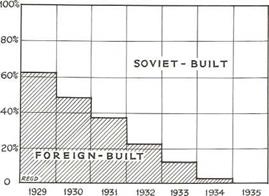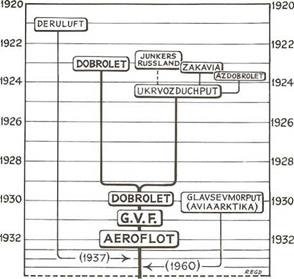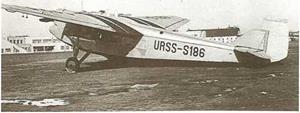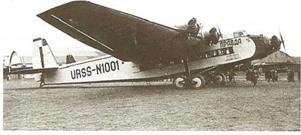Dobrolet Becomes Aeroflot
Growth of an Aircraft Industry
The Polikarpov U-2 (or the Po-2 after the death of Polikarpov in 1944) made its first flight on 8 January 1928. A two-seat biplane, it was to become a maid-of-all-work, and particularly an elementary trainer. Thousands of them were built, used even for bombing in the Great Patriotic War, and Nikolai Nikolayevich Polikarpov’s design was an essential factor in the development of Soviet aviation, akin to the role played by Britain’s Tiger Moth and America’s Piper Cub. Production of the PO-2 continued until 1944, and was built in Poland from 1948 until 1953. Produced for 35 years, it was the most popular light aircraft in the Soviet Union.
Of aircraft in the transport category, the ANT (Andrei Nikolayevich Tupolev) series, prefaced by the Models 3 and 4 (see page 19) led to the ANT-9, which first flew on 1 May 1929, and is more fully reviewed on the page opposite. The Kalinin series, already described on page 21, was establishing itself, especially the Model K-5. On 22 December 1930, Andrei Tupolev watched the first flight of his four – engined bomber, the ANT-6, which was put to good use as a transport airplane in 1937 in support of the Polar expeditions (see pages 30-31). Often overlooked, or even ignored by western observers, this was a big aircraft, and no freak, in its time.
Then in 1931, the little Shavrov Sh-2 amphibian and the Stal’2, designed by A. I. Putilov, made their appearance. Of steel construction (Stal is Russian for steel) it could carry four passengers. It first flew on 11 October 1931 from Frunze airfield (Khodinka) in Moscow.
|
|
|
AEROFLOT SERVICE AIRCRAFT 1929-35 |
|
ORIGIN OF MANUFACTURE |
|
О |
|
20% |
|
40% |
|
60% |
|
80% |
|
і 00% |
Reorganization
On 29 October 1930, as a feature of the First Five Year Plan of 1928, Dobrolet was replaced by as an all-state airline, a joint- stock company, Grazdansiy Vozduzhniy Flot (G. V.F.). It acquired Ukrvozdukhput (page 16) and developed a domestic hub at Moscow, with passenger services to all important cities, as far east as Irkutsk.
Air Pravda
On 3 June 1930, the first experimental delivery was made of type matrices of the official Pravda newspaper, and on 4 June
|
|
|
|
The twin-engined PS-9 was the main production version of the ANT-9, (photo: Boris Vdovienko)
1931, it appeared in Kharkov only eleven hours after being type-set in Moscow. On 16 June, a special aviation section was created to ensure matrix delivery to Leningrad, Kharkov, Sevastopol, Pyatagorsk, Grozniy, Odessa, Kazan, Rostov-on- Don, Tiflis, and Sverdlovsk.
A five-engined airliner, the ANT-14, first flew on 14 August 1931. With 36 seats, it was too large for the traffic on airline routes but was used extensively by Pravda for sightseeing and propaganda flights, mainly around Moscow. Only one was built, and its only long-distance foray was to Bucharest; but it carried 40,000 passengers during its ten-year service life, quite an achievement for the time.
Maturity of an Airline
During the 17th Congress of the All-Soviet Communist Party, held in Moscow from 30 January to 4 February 1932, a resolution was passed that "air travel should expand in all directions, as it is one of the important communication links with remote rural regions, and with major industrial centers." On
25 February, Grazdansiy Vozduzhniy Flot (G. V.F.) was reorganized as the Main Directorate of the Civil Aviation Fleet. On
26 March 1932 it was given the trading name of Aeroflot. Aeroflot continued the good work of its predecessors. On
15 December 1933, the final link to the east was completed, by an extension from Irkutsk to Vladivostok (see page 24). Moving up the learning curve, an Aeroflot PS-9 (version of the ANT-9) opened up the first all-Soviet westward route on 31 August 1935, to Prague, Czechoslovakia. The joint Soviet – German airline Deruluft was wound up on 31 March 1937, and in the same year Aeroflot service began from Leningrad to Stockholm, Sweden, in cooperation with A. B.A. The expansion of the Soviet airline was gathering momentum.
|
The only example of the ANT-14, and one of the few five-engined aircraft ever built, (photo: Boris Vdovienko) |

Wright J6 Whirlwind (3 x 300hp) ■ MTOW 6,000kg (13,2001b) ■ Normal Range 1,000km (620mi) ■ Length 17m (56ft) ■ Span 24m (79ft)


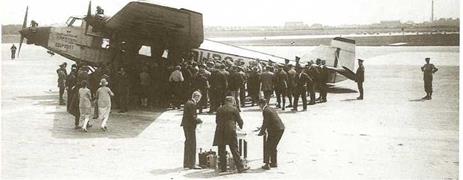
Tupolev Makes His Mark
Andrei Tupolev produced his first multi-engined type, the ANT-9 nine-seat passenger transport, which first flew on 7 May 1929, and was publicly presented in Red Square. It had a metal corrugated fuselage and wing, fixed landing gear, and air-cooled engines, initially Gnome – Rhone Titans. Compared with previous Tupolev designs, it not only looked more elegant and aerodynamically efficient, its performance matched its looks.
Wings of the Soviets
On 10 July 1929, the same day when a common flag was adopted for the civil aviation fleet of the U. S.S. R., Mikhail Gromov took off in the prototype ANT-9, named Krylya Sovyetov (Soviet Wings), on a tour of Europe that included five foreign capital cities. He returned in triumph on 8 August. For the first time, the Soviet Union had an airliner that was possibly the best in Europe. Indeed, there is a report that, calling as it did twice in Berlin, it influenced the Junkers firm to convert the Ju 52 from a single-engined aircraft into a tri-motor. The ANT-9 went into service with Deruluft and Dobrolet early in 1931, initially as a tri-motor with M-26, later U. S. engines. Production of the ANT-9 totaled 75, of which 60 were М-17-powered twins, known as PS-9s, and the type remained in the fleet of Aeroflot until the end of the Second World War.
The tri-motor ANT-9 prototype URSS-309 Krylya Sovyetov (Soviet Wings) at Berlin’s Tempelhof Airport in July 1929, during Mikhail Gromov’s second European tour. Note the three waiters in the foreground preparing champagne for the dignitaries, (photo: Lufthansa)
|
|











